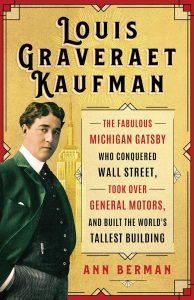Review by Mack Hassler
Oh Jake,” Brett said “We could have had such a damned-good time together….
“Yes,” I said, “Isn’t it pretty to think so?”
“You are all a lost generation”
Gertrude Stein in conversation
The Sun Also Rises, Ernest Hemingway (1926)
 I think Anne Berman manages skillfully and subtly to weave her essentially biographical work on the nearly forgotten Kaufman into a major work on the nature of our country. My suggestion is that she covers not only his importance for Marquette where he was born and he built a splendid mansion that she had been unaware of till given an assignment as a cultural journalist and expert on architecture to write a piece on it; she ends up doing his life story and the story of his family as representative of a pattern that I venture to label “the nature of America.” I like her work here very much.
I think Anne Berman manages skillfully and subtly to weave her essentially biographical work on the nearly forgotten Kaufman into a major work on the nature of our country. My suggestion is that she covers not only his importance for Marquette where he was born and he built a splendid mansion that she had been unaware of till given an assignment as a cultural journalist and expert on architecture to write a piece on it; she ends up doing his life story and the story of his family as representative of a pattern that I venture to label “the nature of America.” I like her work here very much.
What we have is a clear and nearly Biblical pattern of a new promised land and a chosen people, followed by mistakes, ingrained fallenness, eviction from the Promised Land and even, lassitude. Part of Kaufman’s genealogy was European Jewish immigration mingled with a Native American grandmother from the line of Henry Rowe Schoolcraft, who had been an Eastern Mining Engineer who moved out to the Mackinac Island area, married an American Indian woman, and prospered both intellectually and financially as Michigan’s first Agent for Indian Affairs. He did definitive research on the multiple dialects of Indian languages. But when the massive deposits of iron ore were discovered near Marquette just at the time in the mid-nineteenth century when technology and the military needed iron, the “promised land” of the UP took on new meaning Our problems with race and slavery (even anti-Semitism) drove us into our Civil War as well as to the huge wealth coming from the mines. Berman points out well how Schoolcraft (the grandfather of Kaufman) had “callously” enlisted his Native Americans to fight for the North in the War (pp 10-11). Once the War was over and the Union had freed the slaves and young Kaufman had been born (November 1870), Reconstruction and the “Gilded Age” did little for the freed slaves nor the Native Americans.
Young Kaufman quickly grasped the power of investment and recognized the significant wealth opportunities presented by utilizing his hometown harbor for transporting mined materials out of the UP, including copper. Because of the vision he was blessed with, Berman, early in his narrative, says that being a “Yooper” is as much an “experience as living in a place” (7). Also, as I have said, she opens this story of promise as well as evil misuse with her detailed description of Kaufman’s showcase estate (complete with fancy cars as Kaufman by this time had taken control of General Motors) just North of the Marquette Harbor. Later it was his financial skill that funded in New York City the tallest building in the world—The Empire State Building (topped off in 1931). Much of the high work was done by Native American and Canadian Steel Workers) Berman includes in a her documentation an excellent book on the abuse that these brave men had to endure.
Even today we abuse and exploit the indigenous people and the immigrants in our culture. Anne Berman was inspired by some very fancy woodwork done by Finnish craftsmen at Granot Loma, the punning name that Kaufman gave to his mansion, and she includes some excellent black and white photos in he book. Then she went forward herself as a master historian to forge this very substantial work of the Gilded Age and of the Roaring Twenties. I love the ambivalences in the work. As the great Hemingway says, “Isn’t it pretty to think so?” Kaufman died in 1942. Long before the future “promised land” we keep dreaming up for ourselves. He has Berman’s book now to tell his story.
Louis Graveraet Kaufman: The Fabulous Michigan Gatsby, Who Conquered Wall Street, by Ann Berman, cover Louis Graveraet Kaufman, ca 1916, collection of Peter Kaufman, design by Phillip Pacuzzo (Wayne State University Press, Detroit Michigan 48201, 2025), 247 pages, pbk, $28.99.
